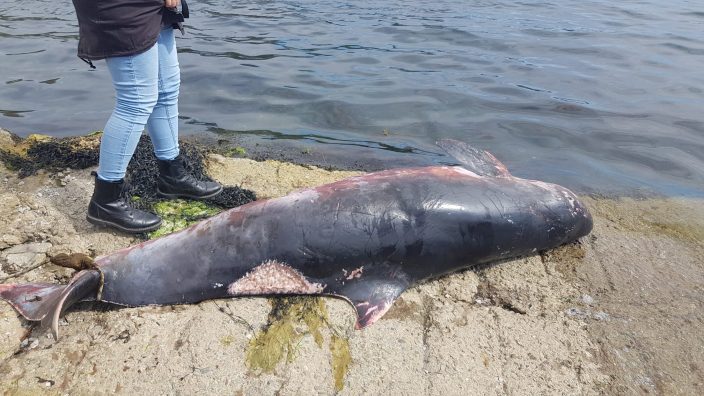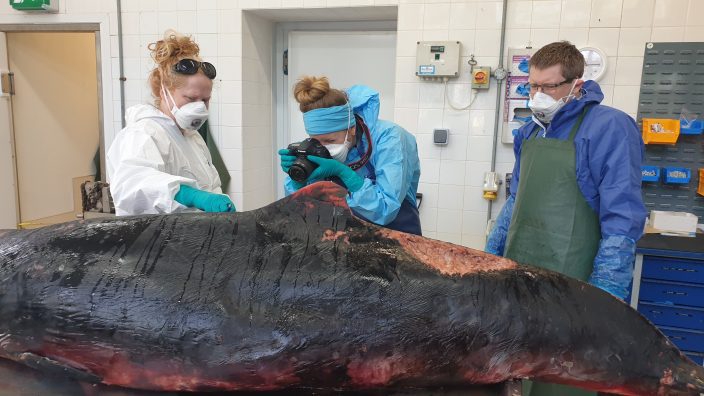A live stranded whale was reported to the IWDG stranding scheme in Glengarriff, Co. Cork on 1 May 2022. Although it managed to refloat itself before members of the IWDG Live Stranding Network arrived to the scene, it was unfortunately found washed up dead the following day. The IWDG can now announce that the whale has been confirmed genetically as a Dwarf Sperm Whale (Kogia sima); a species previously never recorded in Ireland.
A video of the whale live stranded was sent to the IWDG, and it was immediately clear that this was an unusual species. Although we initially thought it most likely to be pygmy sperm whale, Patrick Lyne of the IWDG suspected it could be a dwarf sperm whale and contacted international experts for their opinion, who confirmed that in their opinion it was a dwarf sperm whale due to its taller dorsal fin and smaller back. As this would be a new species to Ireland, we wanted it confirmed before making the announcement.
The carcass was reported the following day and recovered to the Cork Regional Vet Lab where a full post-mortem was carried out by Drs Jim Donovan and Mercedes Gomez-Parada. Whilst there was no obvious cause of death from the gross postmortem, we can confirm the female whale measuring 2.25m was pregnant with a foetus present measuring 315 mm. Prey remains, including squid beaks, were found in its stomach which was recovered together with the whole intestine for further analysis. The skeleton will be prepared by the IWDG and donated to the National Museum of Ireland (Natural History) to be preserved by the state.
This was the second animal to be examined under the new Deep-Diving and Rare Cetacean Investigation Programme (DDRIP) launched by the IWDG recently.
The IWDG sent a skin sample to Dr Eileen Dillane, a geneticist at the School of Biological, Earth and Environmental Sciences in University College, Cork. Eileen sequenced two mitochondrial DNA genes (CO1 and the control region). Both of these genes provided a 99% match with dwarf sperm whale specimens from the Western North Atlantic accessed through Genbank, thus confirming its species.
There were ten previous strandings of pygmy sperm whales (Kogia breviceps) recorded in Ireland, and no sightings, making this species one of the rarest recorded. Ironically, dwarf sperm whales are thought to occur closer to shore than pygmy sperm whales as they inhabit the continental shelf edge and slope. Pygmy sperm whales typically inhabit oceanic waters to the west of the continental shelf.
There is only one record of dwarf sperm whale in the UK – a sighting and photograph of one off Cornwall in October 2011 which was never seen again. Whether we might expect more strandings of this “warm water” species in Ireland and the UK following the impacts of climate change remains to be seen, but it is very important to continue to report stranded cetaceans to the IWDG so we can monitor these trends into the future.
We would like to thank Jo-Ann for sending a video to the IWDG when it live stranded, as well as Christian and Claudine who run the Bamboo Park in Glengarrif for reporting the carcass the following day, NPWS Conservation Ranger Clare Heardman for recovering the carcass and delivering it to the Cork RVL, and to Nathan, Michael, Paddy and Grant who assisted Clare in recovering it. Thank you to Jim and Mercedes at the Cork RVL for their continued support, and to Eileen for analysing the DNA in the skin sample so quickly. We would also like to thank the NPWS for supporting our Deep-Diving and Rare Cetacean Investigation Programme (DDRIP).
IWDG, with its collaborators, will prepare a note for the scientific literature on this new record.
Stephanie Levesque
IWDG Strandings Officer
FOOTNOTE: Many are concerned as to why no one went in to help the animal and why the video was taken. This is the video that was sent to IWDG from the observer when they were reporting the stranding asking for help. There is nothing they could have done as it was thrashing violently on slippery, seaweed covered rocks. From the video we were able to assess the situation to properly inform our live stranding network members who were en route shortly after the animal was reported. Identifying the species and condition of a live stranded animal is important to determine its likelihood of survival, and to assess the best course of action. It is extremely important to understand, if you see a stranded animal thrashing violently in this way, as difficult as it is to watch, you must keep your distance. They can inflict serious injuries upon well-meaning people while in this state. The animal was behaving in this way to re-float itself, which it managed to do by the time our team had arrived.


